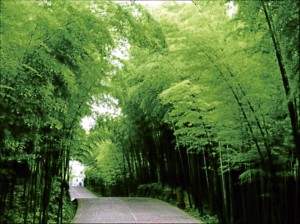
Bamboo. It’s been around us all our lives. It’s something we have so much of that we don’t even think about it anymore.
But, after reading architect Rosario Encarnacion-Tan’s book “100 Things about Building with Bamboo,” it turns out bamboo is something we should begin thinking very seriously about.
It’s precisely because we have so much bamboo that we have to think more about it. It’s an abundant, everyday resource so underutilized we haven’t even begun to realize the possibilities of.
Tan’s book is a great bamboo primer.
Bamboo is sustainable. Several species—123, to be exact, out of a total of 550 worldwide species—grow profusely in our tropical Philippine landscape. Although it has to be manually transplanted, bamboo regenerates so quickly that it seems to multiply before our eyes.
It is environmentally friendly, grows easily even in subsoil or sandy soil, and is good for reforestation or erosion control.
We don’t plant much bamboo any more. From about four-million hectares, we are down to approximately less than a hundred-thousand hectares of bamboo today, and very few bamboo farms still cultivate it.
During a mission to Sichuan province in China, I was taken to survey the Bamboo Forest, where I was astounded by a 120-sq-km primeval ecological bamboo forest with mountains, rivers, karst caves, lakes and falls. The forest is the setting for villages and historic temples.
All houses are of bamboo. Bamboo cooked in different ways was served for our meals. Bamboo is so much a part of the local culture.
Bamboo is also so ingrained in our culture that we take it for granted.
It has been around for a long time. Anthropologist Fernando Zialcita says the bamboo tradition in the Philippines is at least 3,000 years old.
Since our prehistoric days, centuries ago, we have been building houses of bamboo. “Baskets in the sky,” a European scholar once called our bahay-na-nipa, while marveling at the environmental attunement of our traditional dwellings on stilts walled with woven bamboo.
Tan points out that bamboo suffers from the perception that it is poor man’s material.
But the bamboo house is the heir to a rich tradition dating back thousands of years in the Philippines. The knowledge of building techniques is a vanishing oral tradition handed down from one generation to the next.
Bamboo trivia
In “100 Things about Building with Bamboo,” Tan shares a lifetime of researching about bamboo:
1,000 poles of bamboo can build a 200-sq-m house, including the frame for the roof but not including the roof itself.
Bamboo should not be used for roofing because of its susceptibility to UV rays. Exposure to intense sunlight causes bamboo to split. Rains cause waterlogging, which in turn causes bamboo to rot. It is better to use thatch on a bamboo frame for roofing.
Bamboo should not be nailed; it will split and lose its strength. Nylon fishing line is the best material for lashing bamboo.
Bamboo pegs are preferable as bolts for fastening bamboo. They can be made up to an inch in diameter.
Bamboo houses are earthquake-proof because bamboo is flexible, allowing the house to sway with the movement of the ground during an earthquake, relieving stress on the structure.
Bamboo goes well with lumber because both are organic materials; lumber makes a good transition between bamboo and concrete or any other inorganic material.
Bamboo should not be placed against studs, or nailed directly to concrete blocks since these trap moisture, attract insects, and develop into rot.
Bamboo dries faster than any other material after a rain, storm or typhoon.
Bamboo slatted flooring has several advantages: It is inherently decorative, allows ventilation from underneath, has a built-in springiness that makes it pleasant to walk on. It has one disadvantage: Dust falls to the lower floor.
Conventional construction costs are approximately 65 percent for materials and 35 percent for labor; with bamboo, the ratio is reversed to 65 percent for labor and 35 percent for materials.
The best way to live in a bamboo house is to treat it as a living being: It should be cleaned regularly and lived in.
Living in a bamboo house is in the Philippine DNA. The bahay-na-nipa or bahay-kubo is the classic structure that defines the Filipino cultural identity.
Being in a bahay-kubo for many Filipinos is returning to their roots. The houses are open, with space surrounded by more space, such as balconies wrapping around the entire house, latticework windows, and panels that circulate air.
Interiors are multifunctional, designed for maximum flexibility and openness, with only bedrooms enclosed for privacy.
The bahay-kubo lifestyle evokes simplicity, closeness to nature, and radiates a sense of calm now being lost to the modern, urbanized Filipino.
“It might be a subjective experience on my part, but a bamboo house seems to exert a subtle influence on the people inhabiting it. It almost seems to be a living being.”
The City of Manila recognized Tan’s mission to make Filipinos rediscover our bamboo architecture tradition by awarding her the Sining at Kalinangan 2010 Medal.
She’s a heritage hero.
“100 Things about Building with Bamboo” is available directly from the author. E-mail ning.encarnaciontan@gmail.com